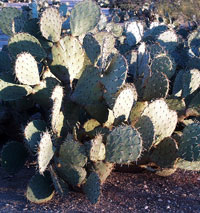|
Cactus (Cactaceae) Members of the cactus plant family exhibit a variety of strange shapes, spines, and showy flowers. Even though today they are found around the world, all species of cacti except four tropical varieties are native to the Americas. Cactuses, like every group of living organisms, vary greatly. Some cactuses look like pincushions; others resemble starfish or even blades of grass. There are about 2,000 different species of cactuses. Even within a certain specie, cactus exhibit a certain amount of variation between individual plants. In other words, every cactus of a given species does not look exactly alike. For example, spines may vary in length and color. |
|||||||||||||||
|
Characteristics: Most cactus are stem succulents; that is, they have fleshy or succulent stems. With the exception of a few tall species and chollas (pronounced CHOY uh), cactuses have no or very little woody tissue. Cactuses native to North America never have leaves on mature growth. Tiny leaves that soon dry up, do sometimes form on the young stems of prickly pear and cholla (Opuntia). Instead, cactus spines are believed to have evolved from leaves. Most cactus cannot remove water from cold soils; therefore winter is the dormant season and summer is a time of active growth. Size: Cactuses vary widely in size and shape. The giant saguaro looks like a bare tree with a thick trunk and long, upturned branches and can grow as tall as 60 feet (18 meters). Other cactuses measure less than 1 inch (2.5 centimeters) high. |
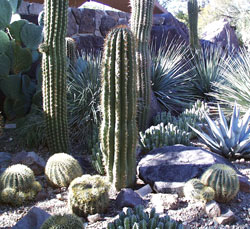 |
||||||||||||||
|
Desert
Garden
|
|||||||||||||||
|
Where Do They Grow? Most cactus species grow in hot, dry regions. In North America they are prevalent in Mexico and many parts of the Southwestern United States. But cactuses can also be found on mountains, in rain forests, and some even grow in Alaska and near Antarctica. |
|||||||||||||||
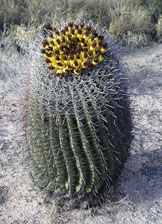 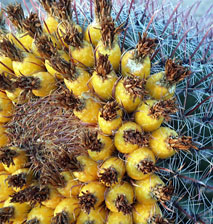
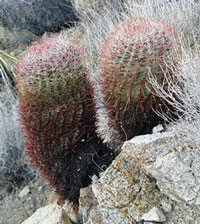 |
|||||||||||||||
|
Arizona
Barrel Cactus
|
Barrel
Cactus Fruit
|
California
Barrel Cactus
|
|||||||||||||
| Parts of a Cactus: The structure of cactuses enables them to survive in hot, dry climates. Most have thick, fleshy stems with a waxy skin surface. The stem acts as a reservoir to store water. The tough skin keeps the water from evaporating. In addition, surfaces of most cactuses can expand and contract to accommodate changes in the amount of water. | |||||||||||||||
|
|
Cactus spines keep the plant from being eaten by most animals. Cactus spines can be short, long, soft or sharp depending on the species. Spines can be straight or have hooked tips. Spines grow on the stem in clusters out of small lumps or mounds, called areoles. Areoles occur in regular patterns on the stem. In some species, such as the saguaro and the barrel cactus (Above photos), the areoles merge to form ribs that run along the length of the stem. The ribs give the plant shade and help the stem store water. There are two main types of spines: (1) centrals that are heavier, more deeply pigmented, and often hooked and (2) radials that are usually straight and scattered around the centrals. |
||||||||||||||
| Engelmann's Prickly Pear | |||||||||||||||
|
Some cactuses are fluted or ribbed. Others have shape protuberances called tubercles. In cactus with tubercles, the spine-bearing areoles are located at the tips. Tubercles of some cactus species are grooved on their upper surfaces; those grooves are an extension of the areole. All cactuses produce flowers. Areoles are where both spines and flowers usually originate. They are distributed in a pattern along the stems and sometimes have felt and long hairs. Again dependent on the cactus species, flowers can be white or a bright color such as yellow, orange, red, or lavender. For most cactuses, flowers are short-lived; the bloom lasts only a few days. Some flowers open only at night. In a few species, the bloom opens for a day or less before withering and falling off. The short blooming period of cactuses lessens the amount of water that evaporates through their soft petals. |
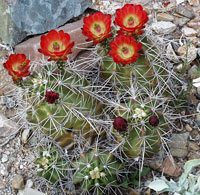 |
||||||||||||||
|
Claret
Cup Hedgehog
|
|||||||||||||||
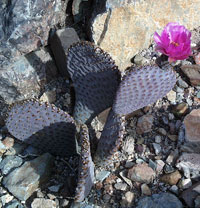 |
In the cactus family, it is difficult to distinguish between the sepals and petal of flowers. They gradually change from one to the other, going from green to brightly colored. These perianth flower parts, the outer envelope, and numerous stamens are joined at their bases into a floral tube. These floral tubes also vary in length from one species to another. The floral tube in turn arises from the ovary. The ovary forms the lowest part of the flower and is where seeds develop and become fruit. The cactus ovary may be spiny, hairy, scaly, or smooth. Cactuses have extremely long roots to reach out through the sandy, rocky soil. These roots grow close to the surface, collecting as much water as possible. A large saguaro may have root systems that are 50 feet (15 meters) long. After a heavy rain, these roots soak up and transport large amounts of water back to the plant stem. |
||||||||||||||
| Beavertail Prickly Pear | |||||||||||||||
|
Life Cycle: All cactuses reproduce. Their flowers have both male and female parts. The male part yields pollen, a yellow powder. In order for the cactus to reproduce, its pollen must fertilize an egg cell in the female part of the plant. Birds, bats, and insects are attracted to the bright colors or the scent of cactus flowers. While feeding, these creatures transfer pollen from one part to other parts of the plant. Some of the pollen reaches the female egg cells. This process is pollination. From the fertilized egg cells, a fruit develops. This cactus fruit is a fleshy berry that contains black or brown seeds. Cactus seeds are scattered by birds, wind, and rain. A cactus plant may produce about million seeds during its life, but only one or two seeds live long enough to produce a new cactus. |
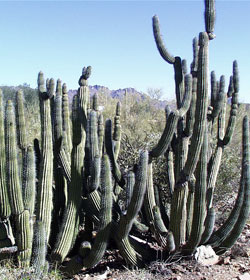 |
||||||||||||||
|
Organ
Pipe
|
|||||||||||||||
|
Some cactuses reproduce both sexually and asexually; reproduce without seeds and flowers. Both prickly pear and cholla cactuses have stems with weak connecting joints. Oftentimes a part of a stem is knocked off and sticks in the ground. If conditions are right, that stem segment can sometimes grow new roots and establish a completely new plant. It then develops its own stems and flowers. Most cactuses grow very slowly. Young plants can take a year or more to reach a height of 1 inch (2.5 centimeters). Older plants may grow 3 or 4 inches (7.5 to 10 centimeters) each year. Cactuses in their natural environment live 50 to 200 years. Kinds of Cactuses: Some of the most common cactuses found in the Southwestern United States include the barrel, prickly pear, organ pipe, cholla, barrel, and saguaro cactuses. |
|||||||||||||||
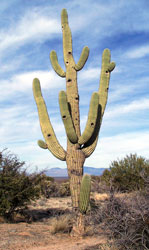 |
Saguaro, organ pipe, and barrel cactuses are members of the subfamily Cereioideae. The saguaro, pronounced se-WAR-oh, may have as many as a dozen armlike branches. The main stem of the saguaro usually grows to about 40 feet at maturity; however, a few true 'monarchs of the desert' have reached near 60 feet (18 meters) and 2 feet (0.6 meter) in diameter. Saguaro branches and trunks provide homes for many birds such as Gila woodpeckers, gilded flickers, elf and screech owls, purple martins, and house finches. A fifty foot saguaro (Left photo) weighs as much as nine tons and can live for as long as 200 years. The organ pipe cactus (Shown above right) has tall stems that grow in groups, looking somewhat like a set of organ pipes. The slender arms of the organ pipe are more sensitive to cold than the massive arms of the saguaro. Their plant surface area is relatively small in comparison to their volume; therefore they experience difficulty in producing enough plant food to stay alive. Branching is a way to increase their surface area, thereby increasing food production. They are found only in the southwestern corner of Arizona, northern Mexico, and a few other, widely scattered locations. |
||||||||||||||
| Saguaro | |||||||||||||||
| The barrel cactus, so named because of their shape, is one of the most common kinds of cactuses. They can grow up to 10 feet (3 meters) tall. But not all barrel cactuses are large; some are tiny. All have prominent ribs and are densely armed with long, tough spines. Barrel fruits always form at the top of the plant, close to its growing point. Both flowers and fruits have no spines, only a few scales. The fruits become fleshy at maturity, some are even juicy, but unlike some cactus fruits, most of these are considered inedible. | |||||||||||||||
|
Chollas and prickly pears are members of the cactus subfamily Opuntioideae. Stems of the jumping cholla, also called chainfruit cholla, fall off so easily that some people say they 'jump' on passerby's. Another variety, teddy bear cholla have brown and tan barbed spines. When the spines pierce tender skin, they are extracted only with difficulty. From far away, the plant's shape and color make it look like a teddy bear. These chollas generally grow to about 5 feet (1.5 meters) tall. Cholla joints are a main building material of desert packrat nests. The packrats construct their dens by mounding cholla joints along with other detritus, such as sticks and prickly pear pads. They clear tiny tunnel pathways through this almost impenetrable thicket, making a safe retreat from foxes, coyotes, and other predators. Some of these nests are hundreds of years old, but should only be examined with protective coverings and breathing apparatus. |
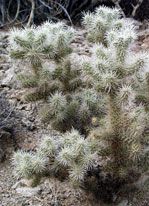 |
||||||||||||||
|
Teddy
Bear Cholla
|
|||||||||||||||
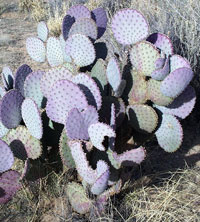 |
Prickly pears, like chollas, are many-branched with each branch arising from another as in a tree. Prickly pear branches, often called pads, are flattened and look like overgrown, fleshy leaves. In addition to the large spines found on prickly pear, they also bear clusters of easily detached tiny, yellow to red spines called glochids. These are found above or on top of the regular spine clusters. These glochids are barbed and very small; therefore, they are hard to remove when stuck into skin. The fruits of many species of prickly pear are juicy and edible. Because the fruits are covered with glochids, they must be carefully peeled before eaten. Some people also gather, cook, and eat the young tender pads of prickly pear as a vegetable. Some animals such as javelinas love to eat prickly pear cactus. You can sometimes see the bite marks on the cactus. |
||||||||||||||
|
Santa
Rita Prickly Pear
|
|||||||||||||||
|
Value of Cactuses: Cactuses are important to animals and people. Small animals, insects, and birds feed on their stems and flowers. Birds build nests in cactus stems. Some woodpeckers make their homes in the larger species. And both birds and animals hide and seek refuge from predators in the stems of cactus plants. Cactuses are also a food source for people. Once the spines have been scraped off, prickly pear stems can be fried and eaten. Many people eat cactus fruits or grind the seeds into a meal for cakes. Some cactuses are important in the production of a red food dye. And other cactuses, once cut and dried have been used as building material, a type of desert lumber. |
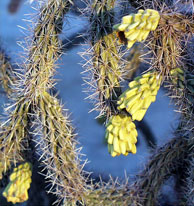 |
||||||||||||||
|
Cane
Cholla Fruit
|
|||||||||||||||
| People in all parts of the world grow and sell cactus plants. Sometimes people dig cactus plants out of natural areas to sell. This practice, called cactus rustling, is illegal in Arizona and New Mexico. Certain species of cactus such as the saguaro and organ pipe are in danger of becoming extinct. National parks and preserves have been established to protect them. | |||||||||||||||
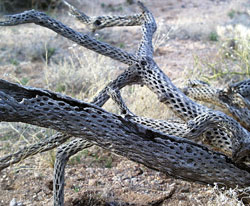 |
Mistaken for Cacti: Newcomers to the Southwest US are sometimes confused by plants that they think are cactus. 'Not-cactus' plants include Century plants (Agave) and hen-and-chicks (Dudleya, Echeveria, Graptopetalum). The latter plants do have succulent leaves in the form of a rosette. Other plants sometimes mistaken for cactus are the various types of Yuccas, sotol (Dasylirion), bear grass (Nolina), and the desert pineapple (Hechtia) that does have leathery leaves. Ocotillo (Fouquieria spendens) has long, wand-like spiny branches, is woody and has normal looking leaves that appear only after rains and is also not a cactus. The only stem succulent that is not a cactus is candelilla (Euphorbia antisyphilitica), a low plant with many slender, crowded, gray-green branches. It has no spines or areoles and its flowers are minute. Candellilla are found almost exclusively in the Texas Big Bend region and Mexico. Examine the photo of the 'Desert Garden' at the top of this page. Can you identify any non-cactus plants? |
||||||||||||||
| Cholla Wood | |||||||||||||||
|
More Information: If you want to learn more about cactuses online, visit the following websites:
Cactus Trivia: Female cochineal insects are found and collected from the pads of a cactus. The 'bugs' belong to the order Homoptera and are related to aphids, scale insects and mealy bugs. The collected insects are dried and the bright red pigments are extracted from the insect bodies. This brilliant red dye is still used by some traditional weavers in the Southwest. One pound of dye represents about 70,000 insect bodies. You can learn more about the cochineal at:
Try a webquest activity. Note:
All photographs taken with a digital camera in Arizona, New Mexico,
Utah, and Texas. |
|||||||||||||||
